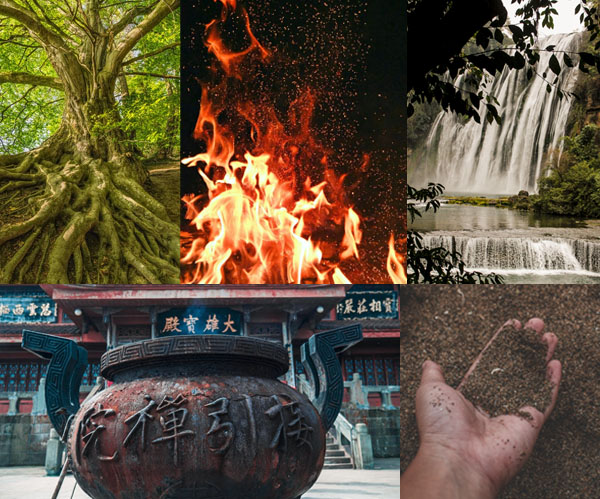Also known as the Five Phases of Energy or the Five Transformations, each of the Five Elements are always associated with Yin and Yang. Their functions were documented by the the 4th century BC, but the basic framework was understood a long time before that. The Five Elements contend that all phenomena of & movement in the universe correspond, in nature, either to wood, fire, earth, metal or water; and that these are in a constant state of movement and change. The Five Elements helps us to generalize and explain the nature of the organs and the inter-relationships between them. I use them as a guide for clinical diagnosis and treatment. The movement of the Five Elements manifests in three basic ways: generating, overacting and insulting sequences. The following defines the Five Element theory using the generating sequence.
Wood
Body: liver and gall bladder; eye; tendon and ligament; birth; anger
Nature: spring; wind; color of green; taste is sour; east
Fire
Body: heart, pericardium, small intestine, triple burner-san jiao; tongue; growth; joy
Nature: summer; heat; color of red; taste is bitter; south
Earth
Body: spleen and stomach; mouth; muscle; transformation; worry
Nature: late summer; damp; color of yellow; taste is sweet; center / middle
Metal
Body: lung and large intestine; nose; skin and hair; harvest; grief
Nature: autumn; dry; color of white; taste is pungent; west
Water
Body: kidney and urinary bladder; ear; bone; storage; fear
Nature: winter; cold; color of black; taste is salty; north
Yin and Yang – The familiar Tai Qi symbol represents the interaction of yin and yang; visible with one portion of darkness gradually becoming lighter with small bright circle remaining in the darkness. The other half of the symbol moves in a contrary pattern with darkness in the light’s center. This symbol represents the assumption that the elements of nature are temporary and always changing. Humans who want to follow nature or be in synch with nature, must act accordingly; be prepared to adapt and change. The two forces are opposite and antagonistic, and complementary as they are combining and cooperating. These two tendencies, constantly interacting, were understood in ancient China to create balance; both inside the body and outside in the world around us.
With the predominance of one tendency / element to give way to the dominance of its opposite, and vice versa, everything is constantly changing. And although constantly changing, each element still contains both yin and yang. This creates a wholeness that is constantly evolving. Bound together, yin and yang unify.
In 1954 China combined Traditional Chinese Medicine (TCM) with Western Medicine. Yin and yang and the Five Element theories contribute to medicine and healing. Traditional practices use them to explain physiology and the disease process in the human body. They serve as guides to diagnosis and treatment.
